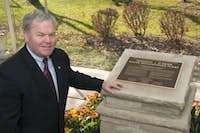Metropolitan Water Reclamation District of Greater Chicago (MWRD) Board of Commissioners President Terrence J. O’Brien has presided over his last meeting, and to honor his 24 years of elected service, his eight fellow commissioners announced at a recent board meeting that the North Side Water Reclamation Plant’s name would be changed to the Terrence J. O’Brien Water Reclamation Plant.
Terrence J. O’Brien was first elected to a six-year term as a commissioner of the MWRD in November 1988. He was the third generation of his family to work for the MWRD; his father, William O’Brien, worked as a painter leadman at the North Side WRP, and his grandfather, John Hickey, served as an operating engineer, also at North Side WRP.
President O’Brien was re-elected in 1994, 2000 and 2006. His proven leadership abilities helped him to be elected president of the MWRD by his fellow commissioners in 1997 for a two year term. As of 2011, he had been unanimously re-elected president eight times.
Stemming from a long career in the environmental field, President O’Brien used his extensive knowledge and experience to ensure that MWRD services are provided at the least possible cost to taxpayers. While serving as president, the MWRD abated over $262 million dollars back to Cook County taxpayers, and the MWRD is one of the few governmental agencies in the State of Illinois to have a AAA bond rating.
President O’Brien spearheaded significant initiatives during his tenure. He lead the successful introduction and passage of a flood and storm water management bill through the Illinois General Assembly, giving MWRD the responsibility of addressing flooding issues throughout Cook County in 2004. He also instituted the 800.332.DUMP pollution hotline for citizens to report illegal dumping of materials into sewers and waterways, enabling MWRD to take immediate action against violators.
Perhaps his greatest achievement focused on the completion of the Tunnel and Reservoir Plan (TARP) in order to protect area waterways and to mitigate chronic flooding problems. Since becoming a commissioner in 1988, President O’Brien obtained approximately $800 million dollars for TARP. TARP is designed to capture sewer overflow before it can pollute the Chicago Area Waterways (CAWS). Since TARP’s implementation in 1985, over 950 billion gal of combined sewer overflow have been captured that otherwise would have polluted the CAWS. The system’s final tunnel was completed in May 2006, making all 109 miles of tunnel operational during rain events in Cook County.
“President O’Brien never missed a Board of Commissioners meeting in 24 years of service,” said MWRD Executive Director David St. Pierre. “Throughout his career, President O’Brien maintained a singular, reliable focus in every decision he made—what is best for the District.”


